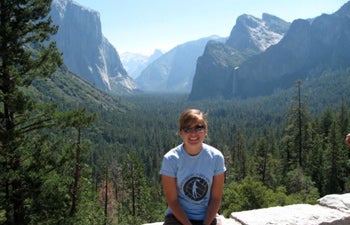Rock ‘n’ Research
Hang around the Department of Earth Sciences in USC College in the spring and you might notice posters on the walls asking pointed questions.
“Enjoy hiking, climbing, and traveling to exotic spots?” one asks. “Curious about earth sciences research?” reads another. “Ever published a professional paper or given a professional talk?”
The posters are advertisements for the Earth Sciences Undergraduate Team Research (UTR) program, an annual opportunity for students to participate in geologic field research at several locations in the United States and abroad. The program is open to all undergrads, even those not in the sciences.
“About sixty percent of our participants are non-earth science majors,” said Scott Paterson, professor of earth sciences and one of two professors leading the UTR program in that department. “Many have no geology background whatsoever.”

USC College senior Phil Ehret examines metasedimentary rocks during a recent research trip in Saddlebag Lake pendant, central Sierra Nevada, along the eastern margin of Yosemite National Park. Photo credit Scott Paterson.
One such student is Phil Ehret, a senior majoring in psychology with a minor in natural sciences. When Ehret joined the 2009–10 UTR team bound for Yosemite National Park, he had never taken an earth sciences course and knew nothing about geology. But he was interested in the opportunity to work in an academic team environment.
“What attracted me the most was that I wasn’t going to be joining someone else’s project or having someone hold my hand,” Ehret said. “I was going to be doing research with colleagues, being treated as a colleague, working with graduate students and faculty.”
The earth sciences department has always offered research and mentoring opportunities for undergraduates. So when, in 2006, the College announced its plan to create formal team research programs under various departments, Paterson and J. Lawford Anderson, professor of earth sciences and current UTR leader, jumped at the chance.
“We were kind of doing it anyway and really liked it,” Paterson said. “We wanted to get our majors out there doing research, but we also wanted people in other disciplines to get exposed to geology.”
Each department in the College is responsible for its own UTR program with funding from the College and the USC Office of the Provost. College money comes from Summer Undergraduate Research Fund (SURF), Student Opportunities for Academic Research (SOAR) and Earth Science Research Apprenticeship Program (ESRAP).
Now with 18 students and nine mentors signed up for the four 2010–11 field options, the Earth Sciences UTR program continues to expand and accommodate its increasing popularity.
In March, a small group of students spent two weeks creating a geologic map of Joshua Tree National Park. In June, another group of students will travel to Mongolia to work with students from the China University of Geosciences in Beijing on tectonic research.
The following month, in April, five students traveled to the Washington Cascades to do work near ancient volcanoes. And in late August, a group of students will spend time in Yosemite National Park to conduct geologic mapping, focusing on metamorphosed volcanic and sedimentary rocks.

Lauren “Brittany” Gelbach, a USC College junior, takes a break from researching plutonic rocks in Yosemite National Park. Photo courtesy of USC College Department of Earth Sciences.
Out in the field, each student researcher works with his and her team, designs a topic for an individual research project and collects data. The following semester, they enroll in a research methods class and eventually present their data during the annual Undergraduate Symposium for Scholarly and Creative Work in the spring. Most students, according to Paterson, do much more.
“They’re presenting at professional geology meetings, some turn their projects into senior theses, and some work with us writing papers for publication,” Paterson said.
The program’s goal is for students to complete team and individual earth science research. The teams learn how to construct geologic maps and collect samples for lab work. The field environment is strongly “learner-centered,” with everyone contributing.
“You get to watch everybody grow,” Paterson said. “I’ve seen this ‘learner-centered’ idea kick in without any pushing from us. Students will start interacting with each other and helping each other; they often end up being the leaders. It’s not like we have to set goals and demand and push — some of the things you have to do in a normal class.”
Outside the confines of the classroom, the UTR program gives students like Ehret and Lauren “Brittany” Gelbach, a member of last year’s Sierra Nevada team, the opportunity to apply classroom lessons in the real world.
“What surprised me was how much I actually learned out in the field,” said Gelbach, a junior majoring in earth sciences with a minor in popular music. “I’d taken geology classes before, but it was much easier to actually see the rock type and put a name to it. I think I learned more in two weeks than I had in my classes. That was good knowledge, but this was applied knowledge.”